Safflower, Oil – Carthamus tinctorius Benefits, Remedies, Side Effects
Kusumbha – safflower is an Ayurvedic herb used for the treatment of intestinal worms, inflammation, joint pain and difficulty in urination.
Latin name – Carthamus tinctorius
Family – Asteraceae
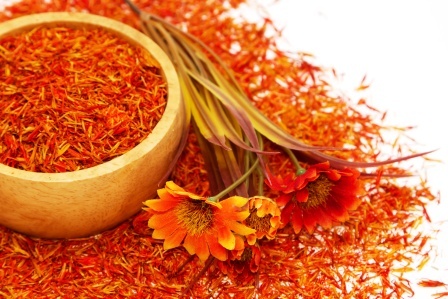
Table of Contents
Vernacular names
Names in different languages:
Hindi name – Kusumb
English name – Safflower, Dyers saffron, Parrot seed, Bastard saffron, False Saffron, Saffron Thistle
Manipuri name – Kusumlei
Tamil name – Kusumba, Chendurakam
Urdu name – Gul rang
Sanskrit Synonyms
Vahnishika – The flower is reddish like fire
Vastraranjaka – Oil was used for dyeing of the cloth
Padmottara, Rakta, Lohita, Pavaka, Alaktam – yellow-reddish coloured flowers
Peetam – yellow coloured flowers
Vastra Ranjana – stains clothes
Safflower seeds are called Kirata, Latva, Varata, Varattika
Morphology
Morphology of Carthamus tinctorius
Safflower is a highly branched, herbaceous, thistle – like annual plant. It is commercially cultivated for vegetable oil extracted from the seeds. Plants are 30 to 150 cm (12 to 59 in) tall with globular flower heads having yellow, orange, or red flowers. Each branch will usually have from one to five flower heads containing 15 to 20 seeds per head. Safflower is native to arid environments having seasonal rain. There are two types of safflower that produce different kinds of oil: one high in monounsaturated fatty acid (oleic acid) and the other high in polyunsaturated fatty acid (linoleic acid). The plant is cultivated for the seed oil in the regions of Punjab, Haryana and Madhya Pradesh of India.
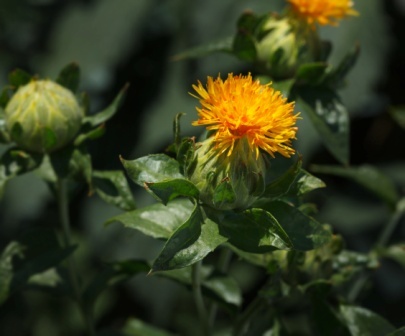
Properties, part used, dosage
Medicinal properties of safflower:
Rasa (Taste) – Katu (Pungent)
Guna (Qualities) – Guru (Heavy), Ushna (Hot), Tikshna (Strong)
Vipaka – Katu (Undergoes pungent taste after digestion)
Veerya (Potency) – Ushna (Hot)
Karma (Actions) – Sarvadosha prakopaka (increase all the three doshas)
According to Bhojana Kutuhalm twelfth chapter, the leaves of kusumbha are sweet and pungent in taste, hot in potency, helps in treating disorders related to urine and faeces. It specially helps in achieving clarity of vision, when take regularly helps in stimulating digestive fire.
Part used – Seed oil, Dried leaf
Dosage –
Dried leaf – 3 to 6 g
Safflower Oil – 10 to 15 ml
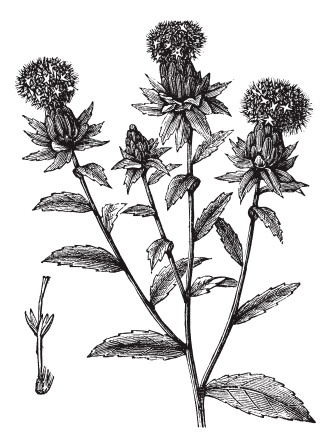
Chemical composition
Chemical composition of Carthamus tinctorius:
Safflower contains carthamone, lignans and a polysaccharide. The poly saccharide, composed of xylose, fructose, galactose, glucose, arabinose, rhamnose and uronic acid residues, stimulates immune function in mice. The plant contains a sesquiterpene glycoside. Aerial parts contain hinesol beta – D – fucopyranoside. The plant also contains luteolin – 7 – glucoside and a propanetriol derivative.
Uses
Medicinal Uses of Safflower:
- Decoction of the dried leaves of Kusumbha is given in a dose of 40 – 50 ml in conditions of difficulty in micturition.
- The leaves of Carthamus tinctorius is made into poultice and applied over the area affected with inflammation and joint pain as part of treatment.
- Safflower oil is given in a dose of about 20 – 30 ml to induce purgation and remove the intestinal worms.
- Safflower oil is useful as part of treatment in conditions of hysteria and physiological disturbances by inducing mild sedative action.
Sanskrit verse
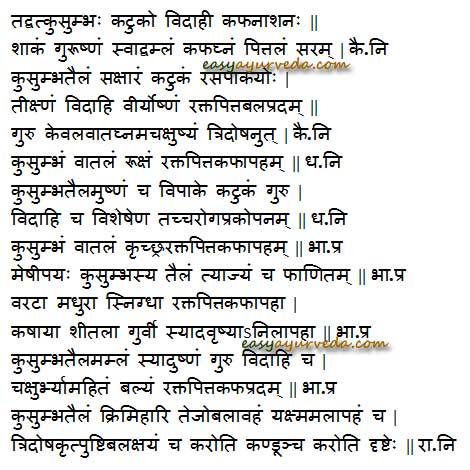
Interaction with medicines, supplements
Can this be used while taking Homeopathic medicine?
Yes. This product does not react with homeopathic medicine.
Can
this medicine be continued while taking supplements like multivitamin tablets,
Omega 3 fatty acids etc?
Yes. Generally, this product goes well with most
of the dietary supplements. However, if you are taking more than one product
per day, please consult your doctor for an opinion.
With western
medicines
Seek your
doctor’s advice if you are taking this product along with other western
(allopathic / modern) medicines. Some Ayurvedic herbs can interact with modern
medicine.
If both Ayurvedic and allopathic medicines are advised together, then it is
best to take Allopathic medicine first, wait for 30 minutes and then take the
Ayurvedic medicine.
Benefits, Indications
Safflower benefits as per Ayurveda:
Safflower:
Katu –pungent, spicy
Vidahi – causes burning sensation
Kaphahara – balances Kapha, useful in productive cough, asthma, bronchitis, chest congestion
Safflower leaves and shoots:
Guru – heavy to digest
Ushna – hot
Svadu – sweet
Amla – sour
Kaphahara – balances Kapha, useful in productive cough, asthma, bronchitis, chest congestion
Pittala – Increases Pitta Dosha
Sara – induces mobility, causes diarrhea, purgation, relieves constipation
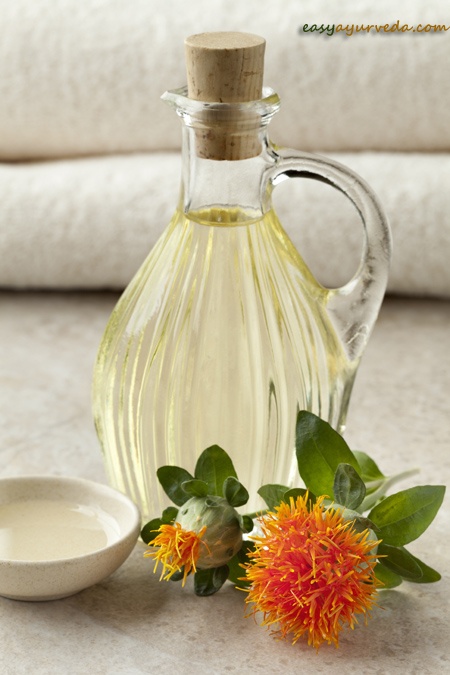
Safflower oil:
Kshara – alkaline
Katu –pungent, spicy
Katu –pungent Vipaka (taste conversion after digestion)
Teekshna – strong, piercing
Vidahi – causes burning sensation
Ushna – hot
Can Cause Raktapitta –Bleeding disorders such as nasal bleeding, heavy periods, etc
Balya – improves strength and immunity
Guru – heavy to digest
Vatahara – useful in treating disorders of Vata Dosha imbalance such as neuralgia, paralysis, constipation, bloating, etc
Achakshushya – not good for eyes
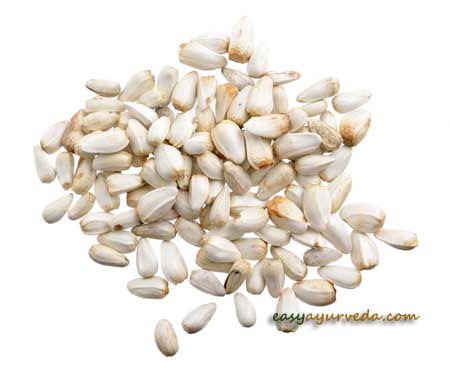
Adverse effect
Safflower is contraindicated in pregnancy, gastric disorders, excessive menstruation and hemorrhagic diseases.
Kusmbha oil is considered as an inferior variety of oil according to Ayurveda due to its properties and hence very less used as medicine or for regular use.
Research
Research articles related to Carthamus tinctorius:
Hair growth action: This study aimed to examine the potential of hydroxyl safflower yellow A – rich C. tinctorius extract (CTE) on hair growth both in vitro and in vivo. In addition, hair follicles from mouse neonates were isolated and cultured in media supplemented with CTE. CTE treatment resulted in a significant increase in the length of cultured hair follicles and stimulated the growth of hair with local effects in mice. The results provided the preclinical data to support the potential use of CTE as a hair growth – promoting agent.
Anti – oxidant and anti – bacterial activity: Antioxidant and antimicrobial activities were studied in safflower methanolic extracts of four different cultivars (IL111, Padide, Isfahan – 28 and Mahali). The total phenolic and flavonoid content of the plant extracts ranged from 46.2 to 62.3 mg gallic acid equivalent/g dry extract and 7.5 to 9.6 mg catechin equivalent/g dry extract, respectively. The antioxidant capacity of methanolic extracts was assessed by reducing power assay, DPPH•(2,2 – diphenyl – 1 – picrylhydrazyl) scavenging activity and β – carotene bleaching methods. Results showed that cultivar ‘IL111’ had the highest phenolic and flavonoid content, as well as an anti – oxidant activity comparable to synthetic antioxidants. In addition, the antioxidant activity of the safflower extracts was evaluated in crude soybean oil by monitoring peroxide and thiobarbituric acid values, which showed a stabilization effect on the soybean oil in the accelerated condition at 60 °C (oven test).
Classical categorization
Bhavaprakasha – Hareetakyadi varga, Dhanya varga
Dhanvantari Nighantu – Suvarnadi varga
Kaiyyadeva Nighantu – Dhanya varga, Drava varga
Raja Nighantu – Ksheeradi varga
Scientific classification
Kingdom: Plantae
Order: Asterales
Family: Asteraceae
Genus: Carthamus
Species: C. tinctorius
Seeds, safflower seed kernels, dried
तद्वत्कुसुम्भः कटुको विदाही कफनाशनः ||८७|| (kayyadeva nighantu)
तद्बीजं कीलता लट्वा शुद्धा पद्मोत्तरा तथा ||१११||
कुसुम्भं स्याद्वह्निशिखं वस्त्ररञ्जकसञ्ज्ञितम् |
कुसुम्भं वातलं रूक्षं रक्तपित्तकफापहम् ||११२|| (Dhanvantari nighantu Suvartnadi varga)
Taste – pungent
Properties – dry, heavy (heavy as it is dried)
Potency – cold (diuretic, raktapittaapaham)
After digestion taste transformation ( Vipaka ) – pungent
Effect on Doshas
Vata increasing (laxative)
Pitta balancing (useful in bleeding disorders)
Kapha nourishing (raw safflower seed is Kapha balancing but since it becomes heavier on drying, it becomes more Kaphakara)
Seeds, safflower seed meal, partially defatted
Decorticated meal is referred to as safflower meal. It is produced after removal of most of the hull and oil from safflower seed.
Taste – pungent
Properties – dry, not very heavy (heavy as it is dried, but reduced heaviness as most of the hull and oil are removed)
Potency – cold (diuretic, raktapittaapaham)
After digestion taste transformation ( Vipaka ) – pungent
Effect on Doshas
Vata increasing (laxative)
Pitta balancing (useful in bleeding disorders)
Kapha neutral (safflower meal is dry, oil has been removed)
Author: Dr.B.K.Prashanth M.D (Ayu), Ph.D
E mail: [email protected]
Click to consult Dr Prashanth BK











One comment
Mishtu
Very informative.Please do a post on multicystic ovarian syndrome.How does it differ from Polycystic ovarian syndrome?